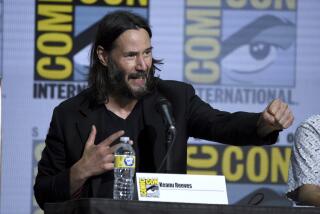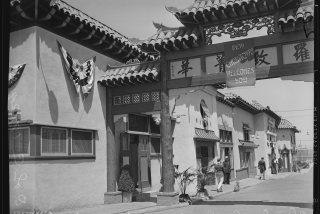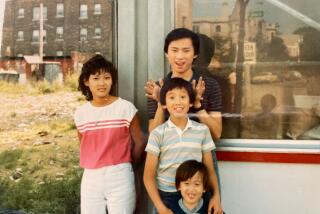Comes the Counterrevolution : CHUNG KUO The Middle Kingdom<i> by David Wingrove (Delacorte: $19.95; 592 pp.) </i>
- Share via
Dawn, autumn of 1987, LAX.
A gritty band of of Hung mao from Cal State Northridge assembles for a brave new foray into the Middle Kingdom--a pioneer semester at Xian U., to be precise.
“Learn that Chinese!” a sleepy father exhorts his departing daughter. “Comes the revolution . . .”
Morning, winter of 2190, geostationary orbit 160,000 li above the planet’s surface. Li Shai Tung--”T’ang, Son of Heaven and Ruler of City Europe” to be precise--looks down upon a frost-colored Earth and contemplates the counterrevolution.
The Dispersionists are threatening the natural order of things, namely the ramrod rule of the Seven T’angs (one for each continent/city).
The Dispersionists, in the main, are the semi-despised Hung mao--literally “redheads,” figuratively barbarians, or worse: “Europeans.” Never satisfied with the status quo, these Hung mao. Besides, they smell. It’s the diet: milk and cheese and all.
The Hung maos’ seditious scheme is to construct a fleet of spaceships to relocate in the stars. With Chung Kuo’s (Earth’s) population nudging 40 billion, it seems a good idea at the time.
The Seven, though, oppose all change, all putative “progress.” That’s what got the world in such a mess in the first place . . .
In “Chung Kuo,” British author David Wingrove has postulated a planet long since conquered by the Chinese. (Just how and why is not made entirely clear. Not to worry; six more 600-page volumes are planned, enough to redress the first book’s inconsistencies.)
Earth has been rebuilt, or rather overlaid with seven domes. Each continent/city has 30 decks. Each deck has 300 levels. Life at the top is grand, a sort of hothouse Beverly Hills. Below is rather like the Bronx, ca 1990, or at the very least, the San Fernando Valley.
One literally rises or falls in the hierarchy according to allegiance or malfeasance.
Under the bottom decks, the crumbling remains of Earth, now called “the Clay,” is populated by sightless white bugs and a host of scabrous, quasi-human mutants who feed on each other and on the sewage generated by 40 billion Chung Kuoans. Picnics are where you find them.
Characters “Above” are as legion, and often as scurvy. When they are not participating in exquisitely stylized ceremonies, they plot, connive, rape, pillage and burn. What with the advanced state of robotics, one is never quite certain who among the Dispersionists is real and who a copy. When all else fails, send in the clones.
Plot and dialogue, courtesy of Wingrove, also equivocate, waffling among the crude, the pedestrian and the rococo. Nevertheless, one suspects that somewhere under the lush green verbiage buds a potentially spell-binding yarn-spinner.
Not yet, though. What with a serpentine story line--and with the six remaining “Chung Kuo” books due in time-release through 1995--the reader is advised to stay on his/her toes. To quote a matutinal Northridge Sinophile, “The journey of a thousand miles begins with a cup of coffee.”
More to Read
Sign up for our Book Club newsletter
Get the latest news, events and more from the Los Angeles Times Book Club, and help us get L.A. reading and talking.
You may occasionally receive promotional content from the Los Angeles Times.










